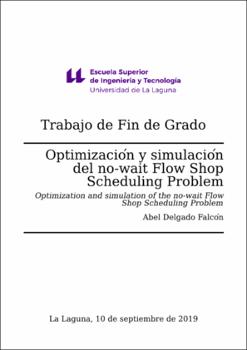Optimización y simulación del no-wait Flow Shop Scheduling Problem
Autor
Delgado Falcon, AbelFecha
2019Resumen
Este trabajo tiene como finalidad la optimización y simulación de un
problema de planificación de tareas conocido como ’flow shop scheduling’, haciendo uso de la restricción ’no-wait’, la cual impide que existan
tiempos de espera entre la ejecución de una misma tarea en diferentes
máquinas. Es un tipo especial de problema que surge a partir del ‘job shop
scheduling’, añadiendo una restricción de orden para el modo en el que
se realizan las tareas. El ’flow shop scheduling’ se puede aplicar tanto al
campo de la informática como al campo de la producción industrial u otros
campos ajenos, como podría ser el paso de un paciente por una operación,
donde tenemos tres tareas que se deben ejecutar en un orden estricto: el
preoperatorio, la operación y el postoperatorio.
Para la fase de optimización, se han utilizado algoritmos heurísticos para
intentar obtener una solución lo más aproximada posible a la esperada
en el menor tiempo posible, ya que el problema es computacionalmente
complejo y por ello se encuentra dentro del conjunto ‘NP-Hard’.
De cara a la simulación, se ha implementado un pequeño programa
basado en simulaciones por eventos discretos, que ha permitido conocer
como se comporta la secuencia obtenida en la optimización bajo un cierto
umbral de incertidumbre y con ello extraer datos para analizarlos. This work is aimed at optimizing and simulating a task planning problem
known as ‘flow shop scheduling’, making use of the ‘no-wait’ restriction,
which prevents waiting times between the execution of the same task on
different machines. It’s a special type of problem that comes from the ‘job
shop scheduling’, adding an order restriction to the way in which tasks
are performed. The ‘flow shop scheduling’ can be applied to the field of
computer science and to the field of industrial production or other outside
fields, such as the passage of a patient through an operation, where we
have three tasks that must be executed in a strict order: preoperative,
operation and postoperative.
For the optimization phase, heuristic algorithms have been used to try
to obtain a solution as close as possible to the expected in the shortest
possible time, since the problem is computationally complex and for that is
inside the ‘NP-Hard’ set.
For the simulation, a small program based on simulations for discrete
events has been implemented, which has allowed us to know how the
sequence obtained in the optimization behaves under a certain threshold
of uncertainty and with it extract data to analyze them.





